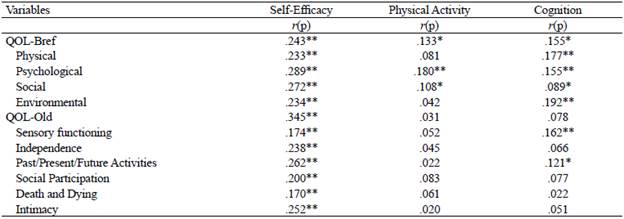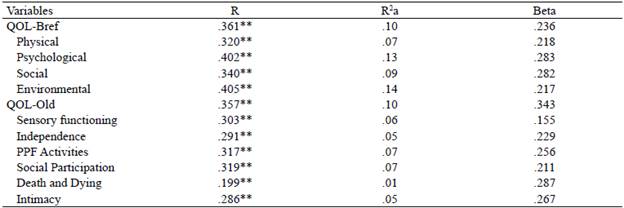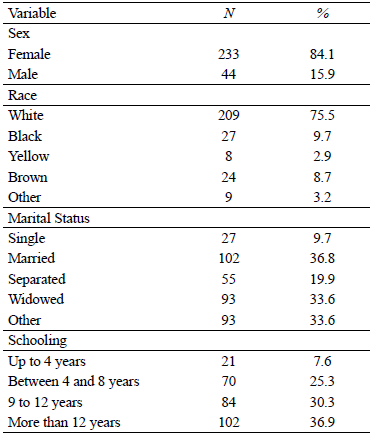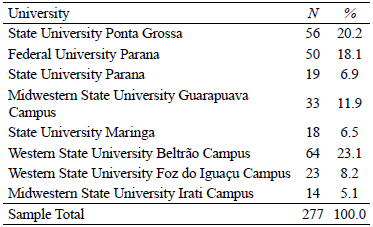Introduction
Open University for elderly people is a form of extension program found worldwide. It has shown itself to be a continuing education tool, both with regard to informal education and health, offering the elderly population access to specialized services (Cachioni et al., 2017; Musselin et al., 2020), as well as social coexistence and continuing education (Mackowicz & Wnek-Gozdek, 2016), and can impact the well-being and Quality of Life of its participants (Adamo et al., 2017; Oliveira et al., 2019). Open University interventions with elderly people can include preventive actions, helping to break negative stereotypes related to aging and helping with Quality of Life (Inouye et al., 2018).
Quality of Life is a broad and comprehensive concept and has been summarized by the World Health Organization Quality of Life Group into overall quality of life and its physical, psychological, environmental and social relationship domains (WHOQOL-GROUP, 1995). Based on this, investigations arise on actions that can impact on the quality of life of the elderly, as observed by Mackowicz and Wnek-Gozdek (2016) in Poland, where active seniors are self-sufficient and independent, despite physical limitations; they have a positive perception towards life; cope better with mood and frustration; do not feel themselves to be a burden to their family and friends; have a good relationship with society, as well as having a positive perception of quality of life.
One of the Open University activities for the elderly is the practicing of physical activity in different modalities. This activity can contribute to various factors in the lives of the elderly, because due to its biopsychosocial nature it promotes physical and mental well-being, social relationships, cognitive aspects and quality of life (Gomes et al., 2017). The review by Gomes et al. (2020) demonstrates that seniors practicing physical activities at Open Universities for the elderly is effective in aspects such as reducing stress and depression, as well as maintaining and improving aspects of cognitive performance and the well-being of participants.
Another factor that can contribute to the quality of life of the elderly is self-efficacy, which can be considered to be a preventive and protective factor for healthy aging (Monfort et al., 2016; Wozniak & Falcão, 2016). Self-efficacy is conceptualized as a personal understanding of how well one is able to perform tasks successfully or achieve positive results in life (Chirico et al., 2017).
According to the review by Medrano-Ureña et al. (2020), there are few studies that relate physical fitness to self-efficacy in adults, however, the studies show that physical activity provides numerous benefits for health or behavior. The authors reinforce that it is necessary for adults to have healthy habits, and not just seek physical activity when diseases become present.
The literature shows that positive perception of quality of life can be associated with practicing physical activity (Medrano-Ureña et al., 2020), cognition (Gomes et al., 2020) and self-efficacy (Monfort et al., 2016; Wozniak & Falcão, 2016). However, studies that have observed how this set of variables can predict quality of life still appear to be scare in the literature.
Therefore, the question is: Is it possible to predict the quality of life of the elderly by time spent doing physical activities, cognition and self-efficacy? Thus, this study aims to verify prediction of quality of life and its domains according to self-efficacy, physical activity and cognition in elderly participants of Open Universities for elderly people in the State of Paraná, Brazil.
Method
Type of study
This was a cross-sectional quantitative descriptive correlational study. This type of study consists of describing and determining the relationship between variables and their prediction (Thomas et al., 2012).
Sample
The study population consists of elderly people participating in Education for the Elderly programs at public universities in southern Brazil, provided, therefore, by a non-probabilistic convenience sample. Its participants were 277 elderly people attending the first year of the "Universidade Aberta à Terceira Idade" and "Universidade Aberta à Maturidade" extension programs. These programs are linked to Paraná State public universities, namely: Universidade Estadual de Ponta Grossa; Universidade Estadual do Paraná - Paranaguá campus; Universidade do Oeste do Paraná - Foz do Iguaçu and Francisco Beltrão Campi; Universidade Estadual de Maringá; Universidade Estadual do Centro Oeste - Irati and Guarapuava Campi; Universidade Federal do Paraná. According to the information provided by the participants, the majority of the elderly were female (N=233, 84.1%), of white skin color (N=209, 75.5%), married (N=102, 36.8%) and had more than 12 years of schooling (N=102, 36.9%). Further information can be found in Table 1 below.
Open Universities for the Elderly are characterized by providing activities and courses for the elderly population, in semi-annual modules, chosen by the participants and according to the number of places available per year. They can offer cognitive activities (arts, crafts, popular culture, languages, among others), physical activities, and a diversity of lectures (including on health). Below is the number of participants in the study per institution:
All elderly people who started the first year of the programs in 2019 were invited to take part in the study. The mean age of the participants was 67.60 (SD = 6.65) and their main characteristics can be found in the results section.
Procedures
This study was submitted to the Research Ethics Committee of the Universidade Estadual do Paraná, Campus 2, and was approved as per Opinion No. 3.018.903, having followed National Health Council Resolution No. 466/2012 (National Health Council, 2012), which provides guidelines and regulatory standards for research involving human beings. All elderly participants signed an informed consent form, indicating they were aware of the procedures and agreed to participating in this study.
Data were collected by a previously trained team, in rooms made available by the participating universities, from May to September 2019. The inclusion criteria were: performing the activities promoted by the "Open University for the Elderly" program and having started them in 2019. Participants were excluded from the study if they had not signed the informed consent form before data collection, were less than 60 years old or did not have sufficient cognitive ability to answer the questionnaires. The interviews were conducted face-to-face, by a previously trained team, which, when necessary, took place in a single day per program at each university (Table 2), with an average duration of 30 minutes each interview.
Sociodemographic
Used to characterize the sample, containing questions on age, sex, race, marital status and schooling. This instrument was prepared by the authors.
WHOQOL-BREF
Questionnaire with 26 items on a 5-point Likert scale (1 for nothing, 2 for very little, 3 for medium, 4 for a lot and 5 for extremely) used to verify perception of quality of life, validated for Brazilian realities - Cronbach's alpha of .91 (Fleck et al., 2000). The overall quality of life scores and the domain (Physical, Psychological, Social Relations and Environmental) scores vary from 0 to 100.
WHOQOL-OLD
Based on the same principals as the WHOQOL-BREF questionnaire, having been developed to assess the quality of life of elderly people with 26 items on a 5-point Likert scale (1 for nothing, 2 for very little, 3 for medium, 4 for a lot and 5 for extremely). This instrument has been validated for Brazilian realities with internal consistency of Cronbach's coefficients ranging from .71 to .88 (Fleck et al., 2006). The overall quality of life scores and the domain (Sensory Functioning, Independence, Past/Present/Future Activities, Social Participation, Death and Dying and Intimacy) scores vary from 0 to 100. According to the WHO, this instrument should be applied together with the WHOQOL-BREF in elderly populations (Fleck et al., 2006).
Generalized Perceived Self-Efficacy Scale (GSES) This scale was developed by Schwarzer & Jerusalem (1995) and validated in Brazil by Sbicigo et al. (2012). The questionnaire consists of 10 questions on a 4-point Likert scale (the first being not true of me, the second hardly true of me, the third moderately true of me and the last totally true of me), and the total score can range from 10 to 40 points. Recently, this scale was applied to the Brazilian elderly population, with a Cronbach's alpha of 0.91. It is therefore an important tool for analyzing self-efficacy of the elderly (Patrão et al., 2017).
International Physical Activity Questionnaire (Matsudo et al., 2001)
Instrument was validated for Brazilian realities with Cronbach's coefficients of 0.75. Comprised of eight questions related to light, moderate and vigorous physical activities. This instrument allows weekly physical activity to be calculated in minutes. Elderly classified as "active" (≥ 150 minutes per week of physical activity) and "insufficiently active" (≤ 149 minutes per week of physical activity), according to the recommendations of the World Health Organization (WHO, 2010).
Addenbrooke's Cognitive Examination - revised version (ACE-r)
This questionnaire was created by Mioshi et al. (2006) and adapted to Brazilian reality by Carvalho and Caramelli (2007). The instrument is comprised of 17 items (with sub-items) intended to assess Attention and Orientation (18 points), Memory (26 points), Fluency (14 points), Language (26 points) and Visuospatial Aspect (16 points), using a score from 0 to 100 (cognitive domains). It is used to detect dementia in elderly people, taking education level into account.
Statistical Analysis
The data were tabulated and analyzed using the Statistical Package for the Social Sciences 24.0 (IBM®). A descriptive analysis was made of the variables involved. Before the main analysis, the necessary prerequisites were checked (minimum of 20 individuals per variable, independent of residues, absence of multicollinearity, absence of outliers, normally distributed residues, homoscedasticity and linear relationship between the variables), and all were met. In the normality test (Shapiro-Wilk) the data were parametric. In the inferential analysis, Pearson's correlation test was performed between quality of life and its domains and Self-efficacy, Physical Activity Time, and Cognition. In the prediction analysis, multiple linear regression was performed, with Quality of life and its domains as the dependent variable, and Self-efficacy, Physical Activity Time and Cognition as the independent variables. All tests adopted statistical significance of p<.05. In addition, in the regression test the age, gender, marital status and years of study variables were controlled.
Results
Still with regard to the descriptive analysis, by examining the means of the variables, it is possible to perceive that the elderly had good perception of their quality of life, especially overall quality of life (WHOQOL-BREF) and the physical domain. In the analysis of quality of life specifically in relation to being elderly (WHOQOL-OLD) it was possible to identify better perception in the overall score, and with emphasis on good perception of the Sensory Functioning domain. When analyzing the mean results of the cognitive instrument, good cognitive condition can be identified, as well as a high amount of time per week spent doing physical activity, higher than indicated by the World Health Organization for this age group (WHO, 2010). Further information can be found in Table 3.
Table 3 Descriptive analysis of the overall and specific Quality of life, Physical activity time, self-efficacy and cognition variables of South Brazilian Elderly People.
| Variables | Mean | SD | Max | Min |
|---|---|---|---|---|
| QOL-Bref | 73.87 | 16.70 | 100.0 | 25.0 |
| Physical | 70.80 | 16.35 | 100.0 | 17.86 |
| Psychological | 70.53 | 13.32 | 100.0 | 25.0 |
| Social | 69.61 | 17.65 | 100.0 | 16.67 |
| Environmental | 68.20 | 12.87 | 100.0 | 28.12 |
| QOL-Old | 70.97 | 11.76 | 100.0 | 26.05 |
| Sensory Functioning | 77.60 | 18.07 | 100.0 | 18.75 |
| Independence | 69.75 | 16.23 | 100.0 | 18.75 |
| Past/Present/Future Activities | 71.18 | 16.23 | 100.0 | 12.50 |
| Social Participation | 69.65 | 15.95 | 100.0 | 6.25 |
| Death and Dying | 69.53 | 25.72 | 100.0 | 0.00 |
| Intimacy | 68.05 | 21.83 | 100.0 | 0.00 |
| Self-efficacy | 33.35 | 5.42 | 40.0 | 10.0 |
| Cognitive-ACE-r | 78.87 | 20.00 | 98.0 | 0.00 |
| Physical Activity Time | 580.94 | 487.00 | 3300.0 | 0.00 |
QOL- Quality of life
In the inferential analysis, by means of the Pearson correlation test, Self-efficacy was found to be correlated to overall quality of life (WHOQOL-BREF) and also to specific quality of life of the elderly (WHOQOL-OLD), as well as to all domains of the two instruments, these correlations being of medium and weak magnitude. Regarding physical activity, the test showed that only correlations of weak magnitude were present in Overall Quality of Life (WHOQOL-BREF) and in the Psychological and Social domains. Regarding the cognition of the elderly participants, correlations were found with Overall Quality of Life and in the Physical, Psychological and Environmental domains of the WHOQOL-BREF instrument, while WHOQOL-OLD instrument only revealed weak magnitude correlations in the Sensory Functioning and Past-Present-Future Activities domains. Further information is provided in Table 4.
Table 4 Correlation Analysis of Quality of Life and its domains with Self-Efficacy, Physical Activity and Cognition of South Brazilian Elderly People

QOL- Quality of life, * p< .05, ** p< .01
In the multiple linear regression, after controlling for the age, gender, marital status and years of study variables, it was possible to verify that Self-efficacy, Physical Activity Time and Cognition can explain 10% of overall quality of life (WHOQOL-BREF), while in relation to the domains, all of them proved to be significant, with emphasis on the Environmental domain, for which these variables provide 14% explanation. With regard to the WHOQOL-OLD instrument, the analysis showed that 10% of elderly-specific Quality of Life can be explained by Self-efficacy, Physical Activity Time and Cognition. Regarding the domains of this instrument, we highlight the Past-Present-Future Activities and Social Participation domains, for both of which 7% explanation is provided by Self-efficacy, Physical Activity Time and Cognition. Further information can be found in Table 5.
Table 5 Multiple linear regression analysis of Quality of life and its domains with Self-efficacy, Physical Activity and Cognition of South Brazilian Elderly People

Controlled Variables: age, sex, marital status and years of schooling. PPF= Past/Present/Future. QOL- Quality of Life, * p< .05, ** p< .01
Discussion
This study aimed to verify the prediction of quality of life and its domains according to self-efficacy, physical activity and cognition in elderly participants of Open Universities for the Elderly in the State of Paraná, Brazil. The sample was found to have certain salient characteristics. The first is the prevalence of women in relation to men, as also happens in other Brazilian studies (Inouye et al., 2018). According to Carneiro et al. (2021) this occurs due to the "Feminization of Old Age", because women tend to be more concerned about themselves, unlike men. Another aspect is education, since most of the elderly people interviewed had more than 9 years of schooling. This result is rare in the literature, given that in most studies with Brazilian elderly people, average schooling level is between 1 and 5 years of study (Tavares-Junior et al., 2021).
Self-efficacy proved to be high, and correlations were found with quality of life and its domains, indicating that this construct can contribute to good perception of quality of life. These results corroborate the Portuguese study by Cruz et al. (2017) with elderly people attending Open University for the elderly, indicating that self-efficacy is related to well-being, and consequently to quality of life. Being efficacious in everyday life is important for the elderly, as it may indicate independence in solving daily problems (Moreta-Herrera et al., 2021; Gasparotto et al., 2020).
Physical activity was found to be high. Studies show that regular physical activity is related to good perception of quality of life (Frändin et al., 2016). In the sample investigated here, overall quality of life and the psychological, social, and environmental domains were related to the amount of time spent doing physical activity. The study by Alves et al. (2020) with Brazilian elderly attending Open University for the elderly did not identify any relationship between physical activity and quality of life and its domains, while the study by Skwiot and Juskiewicz-Swaczyna (2017), with elderly Polish people, also attending Open University for the elderly, indicated that those who practice physical activity tend to have a better perception of quality of life compared to those who do not. Physical activity therefore plays an important role in perception of quality of life. This can occur due to physical fitness arising from this practice (Frandin et al., 2016), increasing independence (Pieczynska et al., 2019), social relationships (Gomes et al., 2020) and improvements in psychological issues, especially depressive conditions (Zanetidou et al., 2017).
The study indicates a high score for cognition correlated to overall quality of life and the physical, psychological, and environmental domains. Preliminary studies point out that the participation of the elderly in cognitive stimulation programs such as those of the Open University for the elderly, may contribute to cognitive status and positive perceptions of quality of life (Inouye et al., 2018; Kim et al., 2019). The result found may also have occurred due to high levels of education. According to Lin et al. (2020), this aspect may contribute to cognitive processes in the elderly.
Self-efficacy, physical activity and cognition explained 10% of the overall and specific quality of life of the elderly participants. Rosanti et al. (2014) indicate that elderly people who practice physical activity have better self-efficacy and cognitive aspects compared to sedentary elderly people. Matson et al. (2019) report that seniors undergoing health reeducation (including physical activity) improved their self-efficacy, as well as their perception of quality of life. In the study by Nahand et al. (2020), which undertook an intervention with exercises and cognitive training with elderly people, they found that quality of life can be improved in elderly people with low cognitive test scores.
Self-efficacy can contribute to the quality of life of the elderly (Cruz et al., 2017), since by considering themselves capable in performing their tasks, the elderly exercise their independence, producing a sense of well-being and self-sufficiency (Moreta-Herrera et al., 2021), improving emotional and motivational control and positive behavioral patterns (Patrão et al., 2017), thus promoting positive aspects for their health.
Physical activity can also contribute to good perception of quality of life. This occurs due to the biopsychosocial aspect of this practice (Gomes et al., 2020), because it promotes increased mobility (Skwiot & Juskiewicz-Swaczyna, 2017), cognitive improvements (Nahand et al., 2020) and increased social interaction (Matson et al., 2019), especially in collective practices, resulting in their well-being and positive health conditions (Frandin et al., 2016).
Regarding cognition, the stimulation that occurs at Open Universities for the elderly combined with high education levels contributes directly to perception of quality of life (Kim et al., 2019). Staying cognitively active contributes to the elderly coexisting socially with other people (Gerino et al., 2017), problem solving (Nahand et al., 2020), promoting well-being (Yuan et al., 2021) and protective action against cognitive decline (Lin et al., 2020).
Therefore, together the constructs of Self-efficacy, Cognition and Physical Activity can directly contribute to the development of positive perception of quality of life. This study has limitations. The first is the non-extrapolation of data, since it is not yet possible to express Brazilian reality. Another limitation is the high educational level of the elderly we interviewed, as this is rare in the Brazilian reality.
Final Considerations
This study found that quality of life can be explained by the constructs of self-efficacy and cognition, along with practicing physical activity. Therefore, places that promote physical activity and non-formal education (Open University for the elderly) produce feelings of self-efficacy, which directly contribute to the quality of life and positive health conditions of elderly people.

















